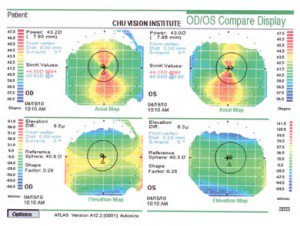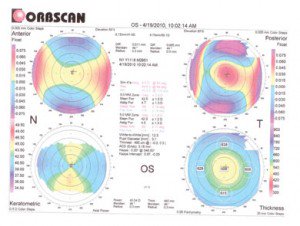Is a premium IOL the right choice?
Click Here to Manage Email Alerts
Case Presentation: A 55-year-old white male presents for a cataract surgery evaluation with complaints of blurred vision that is affecting his vision, especially while driving at night. The patient is well-informed and is interested in presbyopia-correcting lens technology. The patient’s refraction in the right eye is -3.75+3.00×80 yielding 20/70 vision. His refraction in the left eye is -4.75+2.75×80 yielding 20/40 vision.
Brightness acuity testing drops vision to 20/200 in both eyes. Pupil size in mesopic conditions is 5 mm. Pupil size in photopic condition is 3 mm. Anterior and posterior segment is normal with the exception of 2+ nuclear sclerotic and cortical cataracts in both eyes. There is no posterior subcapsular cataract (PSC) noted. The patient is otherwise healthy with no past medical or ocular history.
How would you address the patient’s desire for a presbyopia-correcting IOL? (See corneal topography and orbscan images.)
Approach 1: Jeffrey Whitman, MD
In a younger cataract patient such as this patient, I have strong preference for an accommodating IOL such as the Crystalens AO (Bausch & Lomb). These patients are active day and night, and the AO in my hands gives them the lowest aberration profile of all the presbyopia-correcting IOL’s.
I prefer to do the dominant eye first, shooting for plano to -.25 D target. If there was symmetric corneal astigmatism, I would perform maximal limbal relaxing incisions (LRI), informing the patient that I would most likely have to perform laser vision correction (LVC) at 12 weeks postoperatively, and that is why I would leave them myopic post lens surgery. This allows me to perform myopic LASIK with a target of plano to -.25 D, which has a high level of accuracy.
I would plan the non-dominant eye 2 to 4 weeks after the dominant eye with a similar surgical plan with a goal of -.25 to -.50 D after LVC.
Approach 2: John F. Doane, MD, FACS
My recommendations for this patient depend on what he wants from his operation. If he truly wants less spectacle dependence, then it will require two surgical procedures in each eye: one for the presbyopic IOL implantation, and the other to resolve his corneal astigmatism. Regarding presbyopia correcting IOL’s for this patient, I would suggest an accommodative IOL targeting plano sphere for the dominant eye and -0.5 to -0.75 sphere in the non-dominant eye.
My typical course is to create a femtosecond laser flap prior to IOL implantation, wait for 4 weeks after the IOL implantation and then lift the flap and ablate the residual refractive error. Another option I have heard several colleagues recommend is to convert a case like this to a toric IOL +/- monovision for reading. In this case, there is 3.88 D in the right eye and 4.25 D in the left eye of corneal astigmatism. Currently available toric IOL’s can correct 2.25 D of corneal astigmatism. In this case, if a temporal incision (2.8 mm) is made, an approximate additional 0.5 D will be created with-the-rule. This being the case, the toric IOL alone will not get the patient to less than 0.5 D of residual LVC.
Notably with either approach, presbyopia-correcting or toric IOL, the residual spherical refractive error must be 0.5 D or less, and the residual refractive astigmatism also must be 0.5 D or less for the patient, in my experience, to be happy with their results postoperatively.
Approach 3: Richard Tipperman, MD
This 55-year-old man has visually significant cataracts and a high degree of regular astigmatism. Although in this era of Internet access and readily accessible medical information, where many patients are “well informed,” I have found this is a often thin veneer of knowledge without any in depth perspective. Just because this patient presents with a strong desire for a presbyopia-correcting IOL does not mean that it is necessarily the best choice. As such, I believe it would be important to educate this patient on the potential option of toric IOL implantation with or without blended/monovision. (It is equally important to document this discussion.) Even without adjunctive LRIs, it is likely the patient would achieve 20/30 vision or better with toric IOLs.
If the patient were truly educated regarding IOL options and still wished to proceed with a presbyopia-correcting IOL, he would need to understand and agree to LVC following his cataract surgery to correct his corneal astigmatism. Some surgeons have advocated performing LRIs at the time of the initial cataract surgery, even when LVC is planned postoperatively to “de-bulk” the amount of cylinder that will need to be corrected with the laser. The downside of this approach is that LRIs induce some degree of higher order aberrations, and regression of the LRI affect over time can compromise the refractive outcome achieved by LVC.
Although most patients are stable from both a wound integrity and refractive standpoint at approximately 4 weeks following surgery, I still counsel the patients to wait a full 12 weeks following surgery to achieve the highest level of refractive stability possible. In patients with dense PSCs there can be moderate or significant capsular fibrosis, and therefore a Nd:YAG capsulotomy should be performed to obtain the most accurate refraction. Finally, leaving the patient with a mild degree of myopic astigmatism will typically allow for the best results post LVC.
Approach 4: Satish Modi, MD
Quite simply, I’d tell this patient that he needs a ReSTOR 3.0 in each eye, and he’ll need to wear single vision glasses for 6 to 8 weeks, while the eye stabilizes. He can then have LASIK to treat his astigmatism; 4 D of corneal astigmatism is outside most surgeons’ comfort zone to accurately treat with a LRI.
Happily, since he wants presbyopia correction, the whole discussion of toric IOLs with LRIs, and choice of distance, near or monovision is not discussed at any length. Unhappily, a single complete correction with a ReSTOR/Toric IOL is years away in the U.S.
The patient has a spherical equivalent of about -2.25 D and can see up close without glasses; he would miss that post-surgery if it were decreased, without adequate preoperative discussion. This would rule out the Crystalens, as he would need readers for all small print; on the other hand, if he were a truck driver, with few near demands, the Crystalens would be reasonable so long as he understood he’d still need readers.
To attain good distance and preserve good near vision, he has to be directed to the two diffractive multifocals – Tecnis and ReSTOR 3.0. Unless the patient is short and has high close visual needs (a diamond cutter comes to mind), an IOL with a 4.0 D add would restrict him to a 12 inch focal length, which we have found is too restrictive with the old ReSTOR 4.0 IOL. Also, with a scotopic pupil of 5.0 mm, the scotopic rings are going to be more bothersome with the Tecnis multifocal.
Bilateral ReSTOR 3.0 implantation would give him good distance vision, combined with excellent near vision between 13 and 24 inches. With the area outside the 3.6 mm zone being distance refractive, my experience is that a 5 mm scotopic pupil allows for early adaptation to the rings, and they quickly become a non issue. Also, a 3 mm photopic pupil is not so large that the patient may have trouble reading in low light conditions.
Finally, I have an Intralase and a Wavelight 400; I would perform all-laser LASIK as soon as his corneas and refraction were stable.
Dr. Chu’s approach
Our main concern in assessing this patient preoperatively was his high degree of corneal astigmatism. Although there appeared to be a symmetric bowtie, there was a high posterior float by orbscan, as well as a relatively thin central pachymetry reading. Despite the patient being very motivated in having the right expectations concerning premium IOL technology, we felt that given the currently FDA approved lens technology available, a toric lens would give the patient the best quality vision and minimize his risk and need for further corneal surgery down the road.
The patient was counseled and did fully understand and expect that there would be residual corneal astigmatism after the toric lens implantation, and that further corneal surgery in the form of surface ablation may be necessary. Had there been a toric presbyopia-correcting IOL available in the United States, this may have been a good option for this patient.
The patient did proceed with toric lens implants in both eyes. His surgery was successful. His one-month postoperative results reveals uncorrected vision in the right eye at distance 20/60, uncorrected vision in the left eye at distance 20/30, with both eyes open he was 20/20. The residual refractive error in the right eye was -0.25+2.00×107 yielding 20/20 vision. The residual refractive error in the left eye was -0.25+0.75×066 yielding 20/20 vision. Slit lamp examination reveals well-positioned lenses.
At this stage we are awaiting stabilization and considering further enhancement surgery. The patient is very happy with his current level of functional vision.
Jeffrey Whitman, MD, can be reached at Key-Whitman Eye Center, 2801 Lemmon Ave., Suite 400, Dallas, TX 75204; 214-754-0000; e-mail: whitman@keywhitman.com.
John F. Doane, MD FACS, can be reached at Discover Vision Centers, 4741 South Cochise Drive, Kansas City, MO 64055; 816-350-4539; fax: 816-350-6989; e-mail: jdoane@discovervision.com.
Richard Tipperman, MD, can be reached at Ophthalmic Partners of Pennsylvania, 100 Presidential Blvd., Suite 200, Bala Cynwyd, PA 19004; 484-434-2700; fax: 610-660-0419; e-mail: rtipperman@mindspring.com.
Satish Modi, MD, can be reached at Seeta Eye Centers, 23 Davis Ave., Poughkeepsie, New York 12603; 914-454-1025; e-mail: smodieyes@aol.com.
Y. Ralph Chu, MD, can be reached at Chu Vision Institute, 9117 Lyndale Ave. South, Bloomington, MN 55420; 952-835-0965; fax: 952-835-1092; e-mail: yrchu@chuvision.com.




